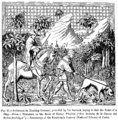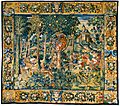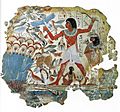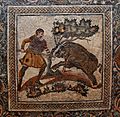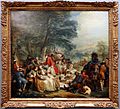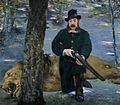Hunting facts for kids
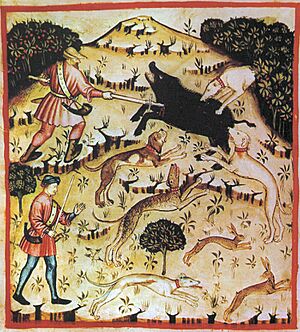
Hunting is when people go out to find and catch or kill wild animals. Animals, and even some humans, hunt mainly to get food. This is called predation. Hunting has been a part of human life for a very long time, going back to the Stone Age, which was thousands of years ago.
In the past, people used simple tools like spears to hunt. Today, hunters often use guns or bows and arrows. Sometimes, animals are hunted not just for food, but also for their fur to make clothes or shelter. Parts of animals might also be used to decorate homes or be sold. For some people, hunting, like fox hunting, is even a sport.
Contents
Why Do People Hunt?
People hunt for different reasons. The most common reason is to get food. Many animals provide meat that people eat. Hunting also helps manage animal populations. If there are too many animals of one kind in an area, they might eat too much food or spread diseases. Hunters can help keep the number of animals balanced.
Hunting for Survival
For many thousands of years, hunting was a main way for humans to survive. Early humans hunted large animals like mammoths and deer. They used every part of the animal. The meat was food, the skins were used for clothes and tents, and bones were made into tools. This was especially important in places where farming was not possible.
Hunting as a Sport
Today, some people hunt for sport or recreation. This often involves following rules and seasons set by governments. Hunters might try to catch a specific type of animal, like deer or ducks. They often use special gear and techniques. After the hunt, some hunters keep parts of the animal as trophies or for their meat.
Hunting Through History
Hunting has changed a lot over time. In the Stone Age, people were hunter-gatherers. This means they hunted animals and gathered plants for their food. They used simple tools made from stone, wood, and bone.
Ancient Hunting Methods
As civilizations grew, hunting became more organized. Ancient Egyptians hunted animals like hippos and crocodiles. The Romans enjoyed hunting boar and deer. In many ancient cultures, hunting was also a way to train for warfare. People developed new tools like nets, traps, and even trained animals like falcons and dogs to help them hunt.
Modern Hunting Practices
In modern times, hunting is often regulated. Governments set rules about which animals can be hunted, when, and how. This is to protect animal populations and ensure fair hunting practices. Hunters need special licenses and must follow safety rules. Technology has also changed hunting, with better firearms, bows, and tracking equipment.
Hunting Rules and Impact
Many countries have strict rules about hunting. These rules are important for several reasons:
- Protecting Animals: Rules help make sure that too many animals are not killed. This prevents species from becoming extinct. For example, the dodo bird became extinct partly because of too much hunting.
- Safety: Hunting rules also focus on safety for hunters and others in the area.
- Fair Chase: Rules ensure that hunting is done in a fair way, respecting the animals.
The Good and Bad of Hunting
Hunting can have both good and bad effects.
Positive Impacts
- Population Control: As mentioned, hunting can help control the number of certain animals. This stops them from overpopulating an area and damaging the environment or spreading disease.
- Conservation Funding: Money from hunting licenses and permits often goes towards wildlife conservation efforts. This helps protect habitats and other animals.
Negative Impacts
- Extinction Risk: If hunting is not controlled, it can lead to animals becoming extinct. This means there are no more of that animal left anywhere in the world.
- Animal Welfare: Some people believe hunting is cruel to animals. They argue that animals should not be killed for sport or pleasure.
Other articles
Images for kids
-
Hunter on a tree or a ground stand during a driven hunt in Finland
-
Bushmen hunter in Botswana
-
Bowhunter in Utah, US
-
Sharp flint piece from Bjerlev Hede in central Jutland. Dated around 12,500 BC and considered the oldest hunting tool from Denmark
-
Artemis with a Hind, a Roman copy of an Ancient Greek sculpture, c. 325 BC, by Leochares
-
Mughal aristocrats hunting a blackbuck alongside an Asiatic cheetah, 1812
-
A group of Sikhs hunting (Unknown Pahari artist, 18th century)
-
Tapestry with a hunting scene, late 16th century
-
Explorer and big game hunter Samuel Baker chased by an elephant, illustration from 1890
-
A Shikar party in Mandalay, Burma, soon after the conclusion of the Third Anglo-Burmese War in 1886, when Burma was annexed to British India
-
Snowden Slights with retriever and shotgun around 1910, 'the last of Yorkshire's Wildfowlers'
-
Hunting camp with dressed deer at Schoodic Lake, Maine, in 1905
-
The coypu is hunted as a pest in Louisiana.
-
Riders gather for a dingo drive in Morven, Queensland, 1936
-
American bison being chased off a cliff as seen and painted by Alfred Jacob Miller, c. 1860
-
Trophy collection of the Princely Family of Liechtenstein at Úsov Château, the Czech Republic
-
Chatelherault, built by William Adam in 1743 as the Duke of Hamilton's hunting lodge
-
Gustave Courbet, La Curée, chasse au chevreuil dans les forêts du Grand Jura (The Quarry, deer hunt in the woods of the Grand Jura) [fr], 1857
-
Albert Gleizes, La Chasse (The Hunt), 1911, oil on canvas depicting a scene in the Cubist style of hunting by horseback in France
-
Hunting of deer and ibex, Minoan larnax, prepalatial period
-
Hunting in the papyrus thicket, mural from a tomb in Thebes, Egypt, before 1350 BC
-
Illustration from the falconry book De arte venandi cum avibus written by Emperor Frederick II, c. 1245
-
Paolo Uccello, Caccia notturna (The Hunt in the Forest), c. 1475
-
Lucas Cranach the Elder, A Stag Hunt with the Elector Friedrich the Wise, 1529
-
Peter Paul Rubens, Hippopotamus and Crocodile Hunt, c. 1615
-
Charles André van Loo, Halte de chasse (Halt During the Hunt), 1737
-
Francisco Goya, The Quail Shoot, 1775
-
Gustave Courbet, Biche morte (Dead hind), 1857
-
Eugène Delacroix, Chasse au lion (Lion Hunt), 1858
-
Édouard Manet, Portrait de M. Pertuiset, le chasseur de lions (Mister Pertuiset, The Lion Hunter) [fr], 1881
See also
 In Spanish: Caza para niños
In Spanish: Caza para niños













